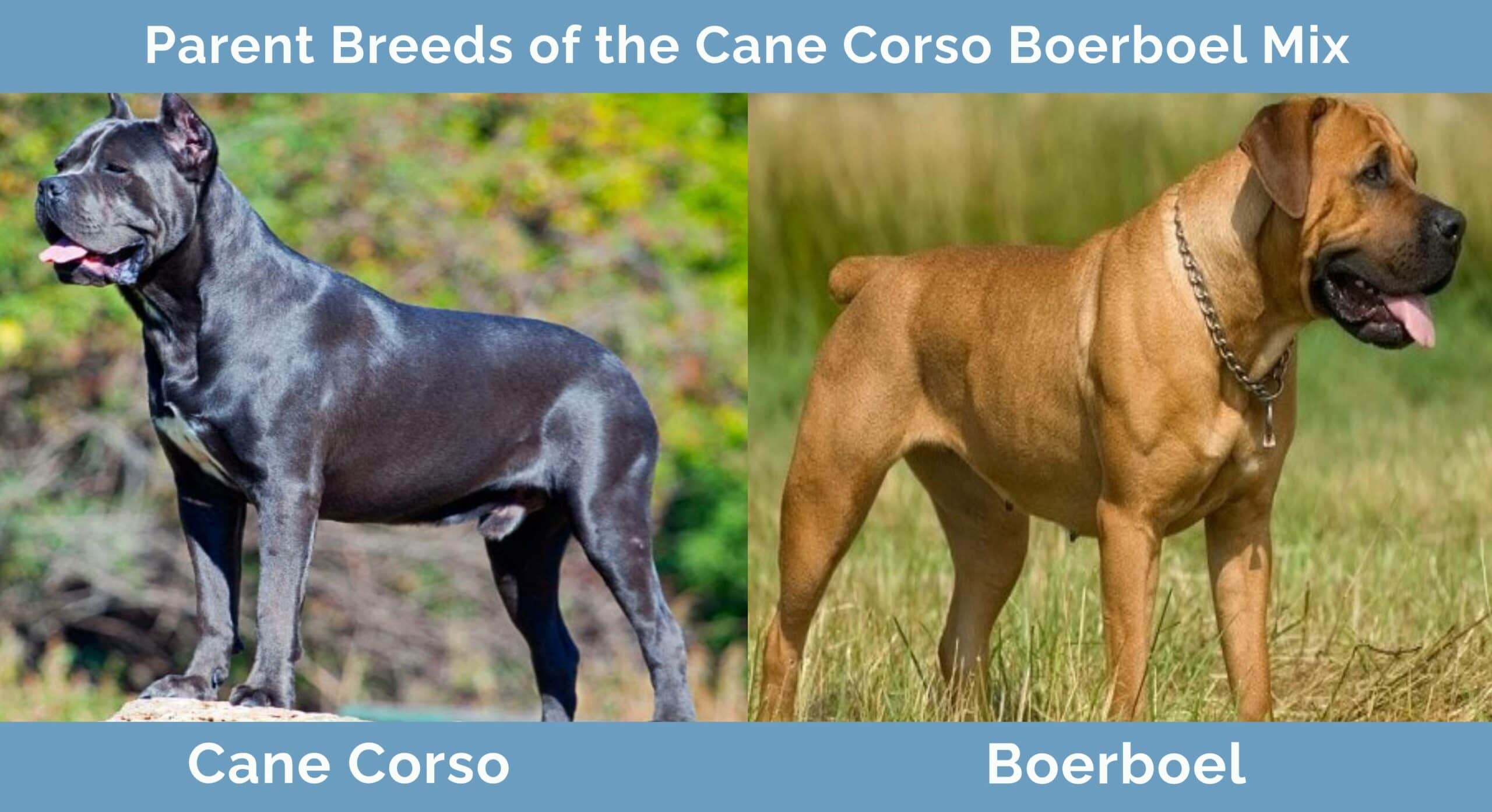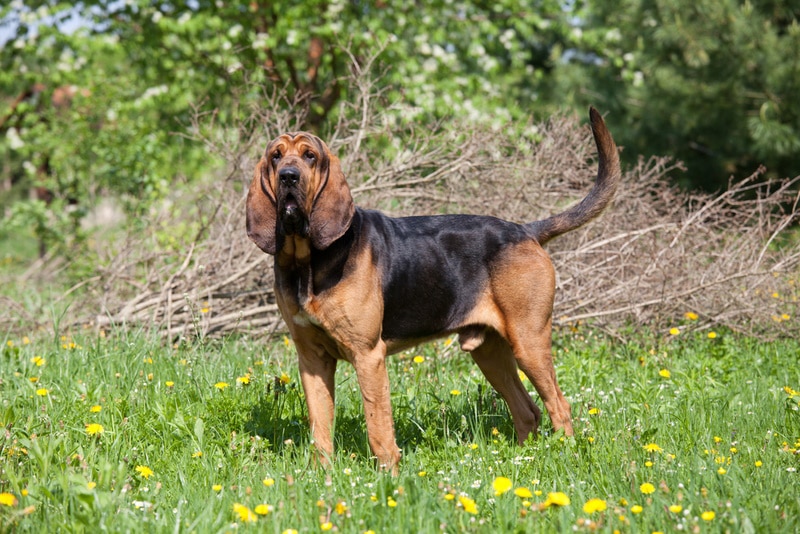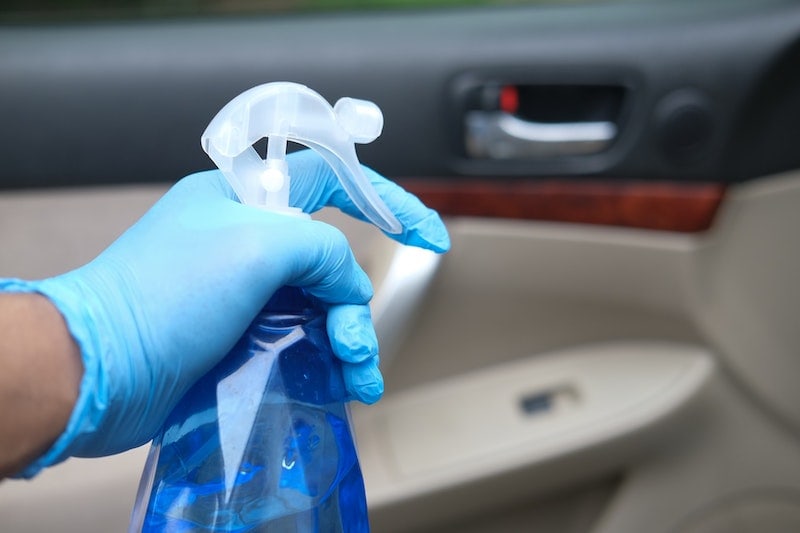Cane Corso Boerboel Mix Info: Pictures, Temperament & Traits

Updated on

Both the Cane Corso and the Boerboel are very large which can make them very intimidating, especially to new dog owners. The Cane Corso is a pretty well-known breed, but the Boerboel is a bit less known. The Boerboel breed originated in Africa during the 1600s and they were later imported to Britain to patrol diamond mines, believe it or not. Cane Corso Boerboel mixes are confident yet very bright dogs that are loyal to their owners and eager to learn and please. They have a large head, powerful jaws, and a big build that can make playing with them quite the workout. Surprisingly, these dogs are also very active, which makes them great for owners who love to partake in outdoor activities such as hiking, running, and cycling. Let’s learn more about this mixed breed so that you can decide if it’s right for you.
| Height: | 24–28 inches |
| Weight: | 154–200 pounds |
| Lifespan: | 10–12 years |
| Colors: | Reddish-brown or tawny |
| Suitable for: | Active families, those looking for a low-shedding dog |
| Temperament: | Loyal & loving, intelligent, easy to train, friendly, gets along with other pets |
Cane Corso Boerboel Puppies
Puppies need to have early training and socialization for creating a loyal and controlled grown dog. These dogs are highly active so families with an energetic lifestyle are perfect for this breed.

Temperament & Intelligence of the Cane Corso Boerboel
Are These Dogs Good for Families? 👪
Yes, Cane Corso Boerboels are good for families, provided that they are well socialized and trained. This breed is loyal and protective of its family and is known to have a gentle and loving nature, but they may get aggressive with strangers, other dogs, or things that they see as a threat if they aren’t well-trained. But, they are highly intelligent and learn very quickly which makes them easy to train.
However, they’re not recommended for families with small children. They can be too protective and may be too rough for small children. They’re also very strong and can be difficult to control. They should be supervised around small children and any children and the dog should be taught how to interact with each other.
Does This Breed Get Along with Other Pets?
The answer to this question really depends on how the dog is socialized and trained. Generally, Cane Corso Boerboels are known to be good with other animals, including cats and other small pets. With proper socialization, they can get along with other pets.
The first step in ensuring that your Cane Corso Boerboel gets along with other animals is to ensure that they’re properly socialized. This means that they should be introduced to a variety of animals in a safe and controlled environment. This will allow them to become comfortable with different animals and help them to understand that they are not the only ones in the house. It’s also crucial to allow the dog to interact with other animals in a positive way, such as through play. This will help the dog to view other animals as friends, rather than enemies.
In addition to socialization, it is important to provide your pup with training. Training your Cane Corso Boerboel to understand commands such as “leave it” and “stay” will help them to respect the boundaries of other animals. And lastly, training the dog to understand that they should not chase or harass other animals will help to ensure that they get along with other pets.
Things to Know When Owning a Cane Corso Boerboel:
Food & Diet Requirements 🦴
Cane Corso Boerboels are considered to be a working breed, and as such, require a specialized diet that is designed to meet their nutritional needs. They have a large, muscular frame and require an appropriate amount of protein, carbohydrates, vitamins, and minerals in their diet. Simply put, they need a balanced diet that is appropriate for their size and activity level. A good quality, commercial dog food that is specifically designed for large breeds is usually a good option.
The food should be high in protein, with at least 25% of the actual calories coming from protein. And it should also provide adequate amounts of healthy fats and complex carbohydrates, as well as other essential nutrients. Both wet and dry foods are ideal for these dogs. You’ll also want to make sure that you give your dog daily treats and cold water to prevent them from overheating – especially during the summer months.
Exercise 🐕
Exercise requirements for these dogs should include both mental and physical stimulation. The Cane Corso Boerboel should get a minimum of 1 hour of physical exercise each day. This should include a good walk or jog, as well as playtime activities like fetch and agility courses – even running around in the backyard with a few toys will be great for these large dogs.
Mental stimulation should also be provided, such as obedience training, scent tracking, and puzzle toys. They may also enjoy activities such as agility, flyball, and farm herding. Keep in mind, it’s best to train these dogs young, as they become very powerful when they’re older. And if they aren’t trained properly they can pose quite a safety risk for owners, small children, and the general public.
Training 🎾
Cane Corso Boerboels are intelligent dogs that thrive on consistency and structure, but they can also be stubborn and independent – and their large size can make this a bit of an issue when they’re adults. It’s best to start training when puppies are about 6 weeks old and able to get around fairly well. Here are a few tips for training a Cane Corso Boerboels.
First and foremost, establish yourself as an alpha. This breed respects strong humans and those with an authoritative nature. Start off by setting clear boundaries and expectations. Offer rewards for appropriate behavior and establish a consistent routine.
Second, use positive reinforcement techniques. These dogs respond best to rewards like treats, verbal praise, and physical affection. Avoid using harsh punishment and negative reinforcement.
Third, give your Boerboel plenty of exercise and mental stimulation in order to stay healthy and well-balanced. Or you may find that they’ll grow into rambunctious and stubborn adult dogs that are really hard to handle. Take your dog for daily walks and provide interactive toys, agility furniture, and puzzles for mental stimulation.
Fourth, this breed can become bored easily, so keep training sessions short and interesting. Use a variety of training tools and techniques for successful training sessions.
Grooming ✂️
Grooming your Cane Corso Boerboel is an important part of their overall health and well-being. Regular grooming can help to keep their coat healthy and free of dirt and debris. They have a short single coat that doesn’t shed a lot, so keeping them groomed isn’t as hard as you may think, given their large size.
- Coat Maintenance: You should brush your Cane Corso Boerboel’s coat at least once a week. This helps to remove any dirt or debris that has become trapped in their fur, as well as any mats that have formed. Additionally, brushing helps to distribute the natural oils in their fur, which helps to keep it looking shiny and healthy. Keeping the coat brushed will reduce the dander in your home and car and make them less likely to have flea and tick issues.
- Bathing: Another important tip for grooming your Boerboel is to give them regular baths, about every 2-3 weeks should suffice. Depending on how often they go outside and how active they are, they may not even need a bath until every 4-5 weeks. When bathing your dog, make sure to use a shampoo that is specifically formulated for dogs, as human shampoo can be too harsh for their delicate skin. Additionally, be sure to rinse them thoroughly and dry them off completely to prevent any skin irritation.
- Nail Trimming: In addition to brushing and bathing, nail trimming is an important part of grooming for your Cane Corso Boerboel. If you are uncomfortable with trimming their nails yourself, you can always take them to a professional groomer to have it done. Nails should be trimmed every 3-4 weeks, and it’s important to make sure you leave enough of the nail so that it does not cause any discomfort or pain.
- Ear Cleaning: Though many of these dogs will already have their ears docked when they’re puppies, many won’t. At birth, the Cane Corso Boerboel has long floppy ears, similar to that of a Golden Retriever. This means that they are more likely to get ear infections and flea issues in this area. So you’ll need to ensure that you’re cleaning your dog’s ears every week with a canine ear cleaning solution and a few cotton swabs. When doing so, you’ll also want to check for fleas and ticks on the inside and outside of the ears, as this is a common area where these pests love to dwell.
Health and Conditions 🏥
- Dental disease
- Diarrhea
- Ear infections
- Intestinal worms
- Hip dysplasia
- Bloat
- Cherry eye
- Hip Dysplasia: Cane Corso Boerboels, like other Cane Corso mixes, are prone to hip dysplasia. Hip dysplasia is a painful skeletal disorder that is more frequent in big dogs. It affects dogs of all ages and may cause osteoarthritis. Overall, it restricts the dog’s range of motion, can cause muscle atrophy in the back legs, and makes it harder for the dog to get around. As a treatment, veterinarians can perform surgery in some cases, but they mostly provide anti-inflammatory medicines, supplements for the joints, and recommend diet restrictions. They’ll also recommend ways to accommodate the dog around the home including installing dog steps, ramps, and other devices to help them get around.
- Bloat: Cane Corso Boerboels are also susceptible to bloat. Bloat is a disease in which a dog’s stomach fills with air or fluid and twists. This specific issue occurs when your dog’s stomach overflows with gas or food and rapidly swells. Typically, this isn’t a life-threatening situation and may pass on its own. If the issue isn’t treated the dog’s health can worsen leading to things like constipation, excessive drool, a distended abdomen, and breathing issues. Minor bloat is often treated with pain medicines and anti-bloat supplements – diet restrictions are often recommended as well (such as feeding the dog smaller portions and less water). However, in more severe cases, surgeons will have to manually untwist the stomach.
- Cherry Eye: Cherry eye is a hereditary eye condition in which the gland in the dog’s third eyelid becomes displaced, causing a bloated red mass to form in the corner of the dog’s eye. All dogs have third eyelids that are located in the eye regions. A gland inside this eyelid (the nictitating gland) can become infected, leading to cherry eye. It’s not particularly harmful, but it may lead to other eye-related issues. Veterinarians usually prescribe antibiotics for this treatment. But ultimately, surgery is typically required in most cases. You may even find that different vets are in disagreement on whether or not to treat this issue with surgery. So, if you find that your Boerboel develops this issue at some point, it may be best to get treatment recommendations from more than one vet.
- Dental Disease: Cane Corso Boerboels, like many canines, are susceptible to dental issues. If left untreated, it can lead to bad tartar buildup, gum bleeding, mouth odor, and eventual tooth loss. Infection and inflammation can also occur in other organs. To maintain good dental health, many dogs require periodic ultrasonic scaling at their veterinarian. Enzymatic toothpaste and treats typically contain enzymes to kill bacteria and eliminate odors in your dog’s teeth and help maintain their dental health. Vets recommend brushing your dog’s teeth once a week to keep them healthy.
- Diarrhea: Cane Corso Boerboels can also have issues with diarrhea at some point. Diarrhea can cause loose, soft diarrhea, which is often caused by an invasion of bad bacteria. This can occur for many reasons, including parasites, food intolerance, infections, toxicity, liver disease, or thyroid problems. For mild or moderate diarrhea, veterinarians will usually prescribe medications, natural supplements, enzymes, probiotics and even food recommendations such as sweet potatoes and bland turkey.
- Ear Infections: Ear infections are a common problem in Cane Corso Boerboels, just like with other canines. They are often secondary to allergies and may also be caused by hormonal conditions, such as a hypothyroid issue. Ear infections can also be caused by the anatomical shape of the ear canals, the buildup of moisture, mucus, and wax, and other factors. Hydrocortisone is great for Cane Corso Boerboels with ear infections in addition to treatments such as Zymox.
- Intestinal Worms: Worms can be a serious problem for Cane Corso Boerboels, especially when they are puppies. And this can also spread to homeowners and their families which is why regular worming treatment is vital to their health. If left untreated, worm infestations can cause loss of appetite, vomiting, and diarrhea as well as anemia. There are also oral prescriptions available for dogs that have worms – many of these prescriptions also prevent heartworms as well.
Male vs Female
Like with most other dog breeds, the male and female Cane Corso Boerboels will vary in size with the male dogs being about 3 to 5 inches taller and height in anywhere from 7 to 15 pounds heavier than their female counterparts. The differences in the two dogs may also be more noticeable if the dog is not spayed or neutered.
Male Boerboels that aren’t neutered are more likely to be hump dogs and people all-year round, while female dogs will go into heat twice a year, and which time you may notice the same activity, while neutered male dogs may also be more aggressive and may be prone to running away from home in search of a mate if they aren’t kept in an enclosed yard. All of this being stated, the main behavioral differences will really be dependent on the dog’s personality and their training.
3 Little-Known Facts About Cane Corso Boerboel
1. Boerboels originated in South Africa
Many of this mixed breed’s Boerboel ancestors appeared in South Africa by way of European settlers. The owner of the Dutch Tea Company in Cape of Good Hope brought these dogs to the continent and they were later bred with other dogs including Boxers and Mastiffs, leading to the Boerboel as it is today.
2. The Cane Corso Boerboel isn’t a purebred breed.
Though these dogs have become more popular over the last 20 years, Cane Corso Boerboels are considered to be a mixed breed. That means that they don’t have official recognition from the American Kennel Club. Breeders are seeing more requests for this mixed breed, so it will be interesting to see how the breed evolves.
3. They’re often used as guard dogs.
The towering size, sheer strength, and dominant nature of these dogs make them great guard dogs for property and homes. In fact, over the centuries, both Cane Corsos and Boerboels have been bred specifically for this purpose.
Final Thoughts
Cane Corso Boerboels are a large breed of dog that is closely related to the Mastiff and was developed in the 1600s specifically as a guard dog and herder of livestock. They’re known to be very intelligent, protective and aggressive, so they should be trained and socialized early on.
Cane Corso Boerboels are great guard dogs, but they can also be aggressive with other animals, including small pets, if not trained. It’s also important for owners to keep a close eye on their pet, as these dogs are very powerful and can be quite stubborn if left to their own instincts. Overall, they can be very loyal and affectionate to their owners and they’re great for active owners who have lots of room in their home.
You Might Also Be Interested in:
- Boerboel vs Cane Corso: What Are The Differences?
- Cane Corso Golden Retriever Mix: Info, Pictures, Traits & Facts
Featured Image Credit: Left – Urszula Drab, Shutterstock | Right – Leoniek van der Vliet, Shutterstock













